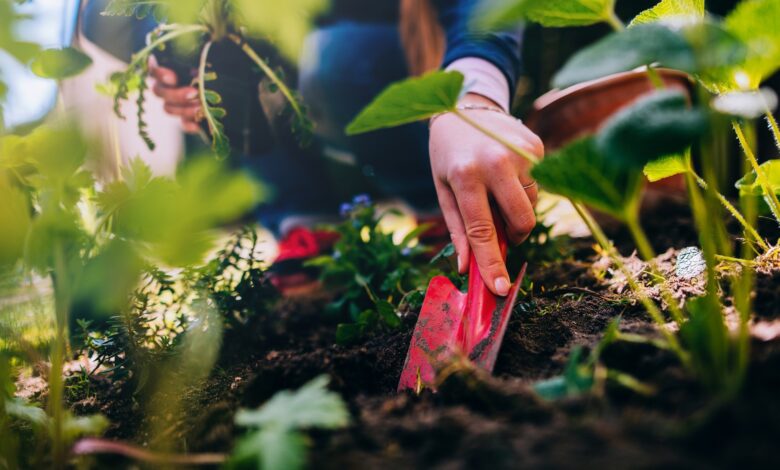Embrace the fun of growing culinary plants in unexpected places

Chaos gardening is a new wave of gardening that is gaining popularity among plant enthusiasts. Gone are the days of traditional garden rows and perfectly manicured raised beds. Chaos gardening embraces a freer, wilder approach to growing plants, where culinary plants are breaking out of the vegetable patch and finding their way into unexpected places like flower beds, sidewalk cracks, and upcycled containers.
But what exactly is chaos gardening, and why is it becoming so popular? Chaos gardening is all about embracing creativity over control. It’s a low-stakes, low-structure approach that allows gardeners to scatter seeds or tuck plants in unconventional spaces, leading to more sustainable ways of growing food. It celebrates adaptability, with culinary plants like mint, thyme, and garlic thriving in unique microclimates or unconventional containers. Even grains like wheat can be grown in front yards, yielding flour for baking.
Horticulturist and author Brie Arthur is a strong advocate for chaos gardening, experimenting with unusual crops like fava beans, sesame, turmeric, and rice. She believes that grains are a fun and practical addition to gardens and containers, citing front yard wheat as her favorite crop that yields over 20 lbs of flour for baking.
The benefits of chaos gardening extend beyond just creativity. By planting edibles in unexpected places, gardeners can create more effective and sustainable ecosystems. For example, herbs like basil, parsley, and nasturtium can attract pollinators, while garlic planted near ornamentals can help reduce pest pressure. Hardscapes and vertical spaces can create microclimates where herbs thrive, and growing among flowers can help disguise plants from hungry critters.
Mushroom grower and educator Misilla dela Llana takes chaos gardening to the next level by growing oyster mushrooms on food scraps like corn cobs, garlic stalks, and even wine corks. She has had success with garlic stalks and corn cobs producing multiple flushes of mushrooms, showcasing the versatility of growing edible mushrooms in unconventional ways.
When it comes to where to tuck edibles, the possibilities are endless. Culinary plants can be planted in flower beds, along walkways and driveways, under shrubs or trees, and even in forgotten containers like rusted wheelbarrows or broken birdbaths. Edible garden creator Wendi Phan repurposes unexpected objects and grows vertically to make the most of small, shady spaces, showcasing how creativity can lead to productive gardening in tight spaces.
Overall, chaos gardening is more than just a quirky trend—it’s a purposeful and empowering approach to growing food. It encourages gardeners to think outside the box, experiment with new plants, and embrace the wild and unpredictable nature of gardening. So why not give chaos gardening a try and see where your creativity takes you in the garden? Garlic is a versatile plant that can be grown as an annual crop but is actually a perennial. This means that the bulbs can be left in the ground to multiply, making it a cost-effective and sustainable option for home gardeners. In addition to traditional methods of propagation, such as planting cloves, some gardeners like to grow garlic from bulbils, which are tiny clones that develop on the scapes of stiff-neck varieties. While this method is slower, it is more economical and disease-resistant in the long run.
One innovative technique that some gardeners use is winter sowing, which involves starting seeds outdoors in the winter months. This not only allows gardeners to get a head start on the growing season but also helps to build resilience in plants. By exposing young seedlings to adverse conditions early on, they become hardier and more resilient in the long run. In regions with mild winters, like the Pacific Northwest’s zone 8b, gardeners can start winter sowing as early as December using recycled milk jugs and DIY cloches to protect the seedlings from harsh weather.
Another creative approach to edible gardening comes from Michelle Akbashev of Everyday Gardening Tips, who turns bay laurel into a decorative container centerpiece. Bay laurel not only adds beauty to a container garden but is also edible, making it a practical choice for home cooks. Paired with other plants like Primo Wild Rose Heuchera and Evercolor Everillo carex, this low-maintenance combo provides year-round interest and fresh herbs for the kitchen.
Ultimately, edible gardening is all about personal preference and creativity. Whether you’re growing cherry tomatoes in hanging baskets, cultivating mushrooms on corn cobs, or planting garlic between dahlias, there are no hard and fast rules. As long as you enjoy the process and the results, you’re doing it right. So go ahead and experiment with new techniques, repurpose old containers, and make your garden a unique and thriving space for culinary plants. The possibilities are endless, and your garden can be a place of innovation and delicious harvests. The Benefits of Meditation for Mental Health
Meditation has been practiced for centuries as a way to cultivate inner peace, mindfulness, and self-awareness. In recent years, scientific research has shown that meditation can also have significant benefits for mental health. From reducing stress and anxiety to improving focus and emotional regulation, the practice of meditation has been shown to have a powerful impact on mental well-being.
One of the key benefits of meditation is its ability to reduce stress levels. When we are stressed, our bodies go into a state of fight or flight, releasing cortisol and other stress hormones that can have a negative impact on our physical and mental health. Meditation has been shown to activate the body’s relaxation response, reducing the production of stress hormones and promoting a sense of calm and relaxation.
In addition to reducing stress, meditation can also help to alleviate symptoms of anxiety and depression. Studies have shown that regular meditation practice can lower levels of anxiety and depression, improve mood, and increase feelings of well-being. By focusing on the present moment and cultivating a sense of mindfulness, individuals can learn to observe their thoughts and emotions without judgment, reducing the impact of negative thoughts and feelings on their mental health.
Meditation has also been shown to improve focus and concentration. By training the mind to focus on the present moment, individuals can increase their ability to concentrate and maintain attention on tasks. This can be particularly beneficial for individuals with attention deficit disorders or those who struggle with distractibility.
Another benefit of meditation is its ability to improve emotional regulation. By cultivating mindfulness and self-awareness, individuals can learn to recognize and regulate their emotions more effectively. This can lead to improved relationships, better communication, and a greater sense of emotional stability.
Overall, the practice of meditation has numerous benefits for mental health. From reducing stress and anxiety to improving focus and emotional regulation, meditation can be a powerful tool for promoting mental well-being. Whether practiced for just a few minutes a day or as part of a more structured routine, meditation has the potential to make a significant impact on mental health and overall quality of life.




